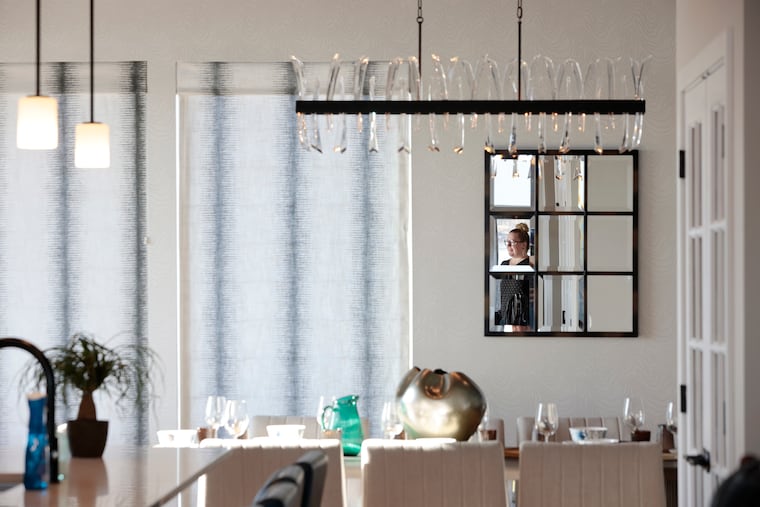Dressing for the occasion: tips for choosing the right window treatments in your home
Privacy, light control, aesthetic taste, and budget are the main considerations when choosing window treatments. Many are energy efficient, can be controlled from your phone, and can fit any budget.

When Kate Watson and David Jacowitz moved into their Fishtown townhouse earlier this year, window treatments were a must. The home had just been built, and 15 windows lay bare.
“We are located right on the Delaware River, and we get a lot of sunlight, so for bedrooms we needed shades that would block as much sunlight as possible so we weren’t blinded in the morning,” said Watson. “We have a gym area where we thought it would be nice to let some light in to enjoy our riverfront view.”
They also enjoy the water view in the living room, where drapes hang on the floor-to-ceiling windows. In the dining room, where light was less of a concern, they chose a patterned Roman shade that matches the aesthetics of the room.
Since they opted for neutral shades, including whites and light grays, they don’t need to worry about matching any new furniture or artwork. Allure Window Treatments created the custom coverings for the standard windows, which weren’t standard sizes, for a total cost of about $20,000.
Privacy, light control, aesthetic taste, and budget are the main considerations when choosing window treatments. Many are energy efficient, can be controlled from your phone, and can fit any budget.
An option to fit every window
Step one in choosing a window treatment is deciding what function you want. Do you need privacy or room darkening? Do you want to preserve your view but filter out some of the strongest UV rays? Are the window treatments an important part of your decor or just a way to control the light?
Once you are clear on the function, decide on the aesthetics. Do you like a pattern or solid, bold color or neutral, drape or blind?
“Look at pictures to decide what style you like,” said Aleksandra Jakubowski, Avant-Garde Design’s lead designer. She owns the Bucks County-based firm with her husband, Tomasz Kiosewski.
The main types of window treatments are shades, drapes, curtains, shutters, and blinds.
Shades: Often made of fabric, vinyl, or bamboo wrapped around a tube, roller shades are available in many fabrics and colors, with light control options.
Drapes, sheers, and curtains: Panels of decorative fabric, draperies are typically floor length while curtains stop at the base of the windowsill. Sheers, which can be either size, are made from transparent lightweight material to filter light.
Shutters: Built around a frame of vertical stiles and horizontal rails, shutters can be solid panels, louvers, glass, or fabric.
Blinds: Composed of slats that tilt open to let in light or closed for darkness and privacy, blinds are sized to fit within the window frame.
Energy efficiency and smart features are other considerations when choosing window treatments.
“You want to prevent heat or cold from coming in from outside and preserve heat and cold inside,” said Roi Albo, CEO and founder of Allure Window Treatments in Old City. “Roller shades, for example, block more than 90% of the sun’s UV rays from coming in. Drapery liners can also serve as an insulation layer.”
The cost of smart features has come down considerably in the last few years. Motorized window coverings can now be adjusted from a smartphone or remote. Not only does motorization take the heavy lifting out of heavy shades, but it allows you to set a schedule based on the time, sunrise and sunset, or your daily routine.
Bold colors and textures
Though grays and whites are still classic, bold patterns and vibrant colors are gaining ground.
“Homeowners are now seeking to infuse their living spaces with a burst of energy and personality through their window coverings,” said Jakubowski.
Linen offers a natural, textured appearance and has breathability and light-filtering properties. Its durability and resistance to fading make it a practical and long-lasting option. Layering different types of window treatments, such as draperies and shades, can add depth and dimension to a space, allowing for greater flexibility in controlling light and privacy.
DIY
Perhaps you’re renting your home and don’t want to invest in costly window treatments, or you want to try your hand at making them yourself.
“Shop at Amazon or in stores like HomeGoods, Ikea, or big box stores,” said Nneka Mosley, owner of the home-design website One Handy Momma. “Or go to a fabric store where it’s really easy to find what you want for as little as a couple dollars a yard.”
If you know how to sew, that’s great, but not necessary. Instead, iron hem tape onto the fabric’s rough edges for a finished look. Cornice boxes, decorative covers over the frame that hang above your window treatment, are another popular DIY project.
“They can be made so inexpensively by using a stiff piece of cardboard, tape, fabric, and some glue,” Mosley said, “and look professional.”
Most importantly, measure carefully. For curtains or drapes, be sure they are long enough, a bit higher and wider than your window frame. Drapes should hang straight and barely touch the floor. Don’t skimp on the panel size.
If you don’t want to make holes in the wall or ceiling, Command strips and no-drill curtain rod brackets are good options.
“Doing it yourself involves trial and error,” said Mosely. “Nobody gets everything right, but there are a lot of easy options.”
Have you solved a decorating, remodeling, or renovation challenge in your home? Tell us your story by email (and send a few digital photographs) to properties@inquirer.com.